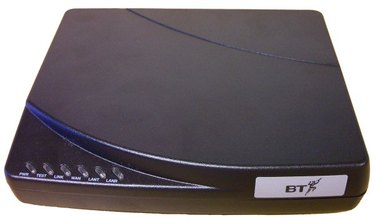
Modem is short for modulator/demodulator. Modems are used to connect with an Internet service provider, and can also be used to send fax transmissions. You can either install an internal modem inside your computer or get an external modem for greater convenience and ease of installation. Once connected, the modem will transfer data back and forth between your computer and your service provider.
Types
Video of the Day
The types of available modems include analog, digital subscriber line (DSL), cable and Integrated Services Digital Network (ISDN). Analog modems are used for dial-up connections. DSL and cable are high-speed broadband connections. ISDN modems transfer information in channels of 64 kilobits per second (Kpbs) which can be combined for higher speeds.
Video of the Day
Features
Most computers come with an analog modem. These dial-up modems can download at speeds up to 56 kilobits per second (Kbps.) Your computer must use the modem to make a telephone call to your service provider in order to connect. This ties up the phone line, so you must disconnect in order to use the telephone for other purposes. DSL modems, on the other hand, transfer signals on frequencies that are not used in voice or fax transmissions. Thus you can use the telephone and surf the Internet at the same time. Cable modems are attached to a coaxial cable. For Internet connections, cable uses bandwidth that is unused in cable television transmissions.
Function
Dial-up modems are only connected to the Internet when they've called in to your service provider. DSL and cable connections, on the other hand, are typically always on. DSL is always digital, but there are both digital and analog cable Internet modems. ISDN is also a dial-up service. It needs a network terminator and a terminal adapter to function. An ISDN modem is an adapter with an analog modem built in.
Benefits
DSL and cable modems are the most efficient and cost-effective tools for connecting to the Internet. DSL connections can range between 128 Kbps and 6 megabits per second (Mbps). Cable connections can be as fast as 30 Mbps. Furthermore, DSL Internet service prices have dropped to the point where they're the same as or lower than dial-up service. Cable service is also available at reasonable prices, and can often be bundled with cable TV service. If you've given up your dial-up service in favor of broadband, you can still use your analog modem to send faxes. Use the Windows Fax Services or purchase specialized fax software to configure your virtual fax machine.
Considerations
DSL and cable Internet service providers sometimes place bandwidth caps on their users. These can lower your Internet speeds considerably. With cable service, the reduction in speed can be dramatic. With DSL, however, the difference will probably be much smaller. Also, DSL and cable companies may cut off service or charge additional fees once users reach their service limit.